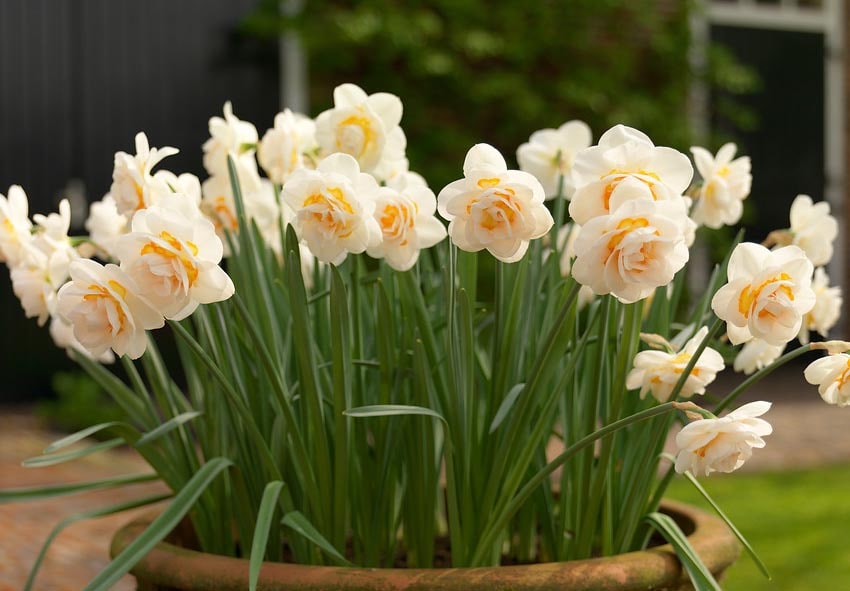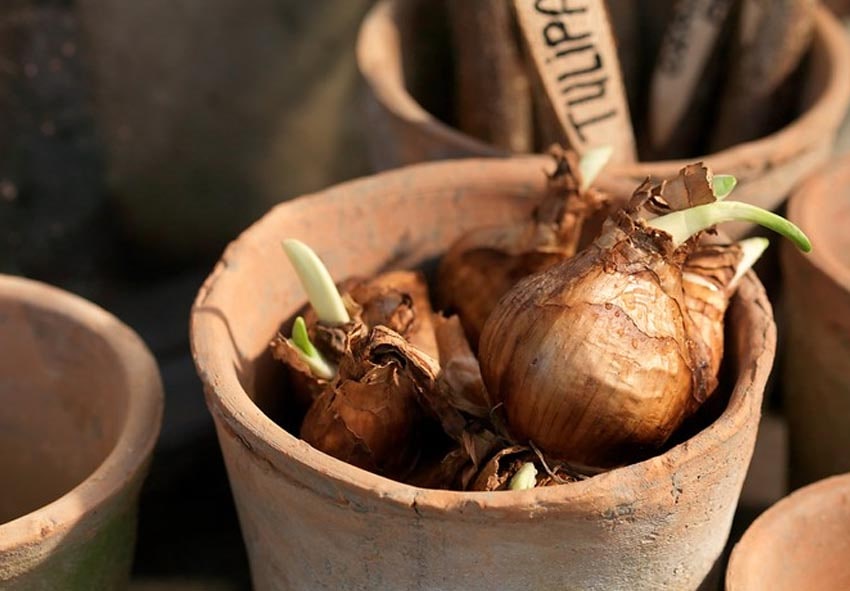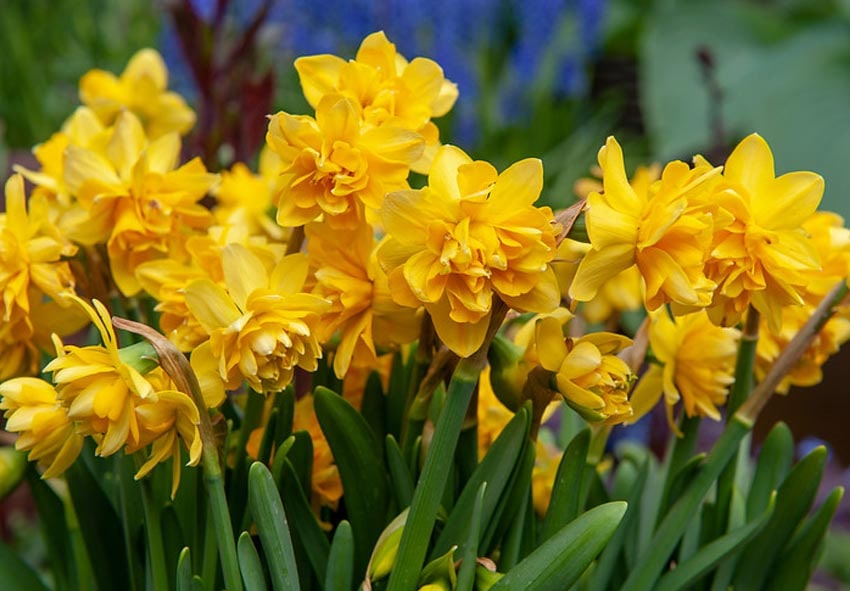Before talking about planting daffodils, it should be mentioned that this flower culture is bred with bulbs. If you plant your daffodil bulbs at the right time, these wonderful flowers will delight you with great blooms. Let’s first deal with the question of when to plant daffodils — in spring or autumn?
Daffodils are a type of flower that grows from bulbs. They are native to Europe and North Africa. Daffodils come in a variety of colors, including yellow, white, and orange. They are usually planted in the spring, and they bloom in the spring and early summer.
Daffodils are often planted in pots because they are easy to care for and look beautiful at home. You should plant daffodils in well-drained soil and make sure there is plenty of sunlight.
Planting Daffodil Bulbs

It is not enough to plant daffodil bulbs on time. You need to plant them correctly, and it is especially important to consider how deep to plant the bulb. Here are some tips for anyone planting bulbs:
- Carefully inspect all the bulbs. Discard bulbs that are soft, damaged, or diseased.
- Soak the bulbs in a fungicide solution to prevent fungal diseases.
- Prepare your landing site. Please note that such plants do not like soils that are too compressed. If the soil at the site of planting daffodils is clay, mix it with sand.
- Make holes for bulbs. Follow these planting depth guidelines strictly: For large narcissus bulbs: 15 cm, for smaller ones: 12 cm, for the smallest bulbs: 7 cm. Add sand under the bottom of the bulb.
- Plant daffodil bulbs at a distance of 10 cm apart for large ones, or 5 cm for small ones.
When to Plant Daffodils in Ireland
Many gardeners argue about when is the best time to plant daffodils. There is only one correct answer – it is better to plant daffodil bulbs in the fall during the dormant period of plants. Remember, the dormant period of daffodil bulbs is shorter than that of tulips. Therefore, the best time for planting and transplanting bulbs is early to mid-September.
Why not repot daffodil bulbs in spring or late fall? The fact is that at the end of September, new balblets begin to form. This means the plants are preparing for the next season. If you start replanting at this time, then some of the roots will inevitably be injured and will not recover. Therefore, it is better to plant daffodils when the bulb is sleeping and new roots have not yet appeared.
Bulbs of daffodils must take root in the soil before frost. This will help them endure the cold winter, but it still does not hurt to cover the flower bed for the winter (additionally insulate it), for example, with peat.
How Deep to Plant Daffodil Bulbs

Planting depth is important for daffodils because they need good drainage. If you plant them too deep, the bulbs will rot. The top of the bulb should be just below the surface of the soil.
If you are planting a large number of bulbs, you can dig a trench about 8 inches deep and place the bulbs there. Thus, you will get a beautiful row of flowers in the spring. Its depth will ensure that the bulbs will not rot. Make a hole about 2 inches deep, drop in the bulb, and cover it with soil.
If you are planting daffodils in containers, make sure the pot has a hole in the bottom so that the water can drain. The bulbs should be planted at the same depth as they are in the ground.
Conditions for Growing Daffodils
Daffodils need well-drained soil. They will not grow in wet soils. The best way to provide good drainage is to add organic matter to the soil before planting. You can use compost, peat moss, or rotted manure.
Daffodils also need a sunny location. They will not flower if they are constantly in the shade. Do not plant taller plants next to them to avoid any unnecessary shadows. A good idea is to create a plan for your garden in advance to know where to plant certain flowers.
If you are growing daffodils in pots, choose a pot that has a hole in the bottom so the water can drain. Also, make sure the pot is large enough to accommodate the bulb. The bulb should be planted at the same depth in the pot as it is in the ground.
Care for Daffodil After Planting

Like other flowers, daffodils require care. This includes timely bursting, feeding, and watering. It is necessary to feed daffodil plants in two stages:
- In the spring, with the appearance of the first shoots: nitrogen fertilizers with ammonium nitrate or urea.
- Before flowering: potassium sulfate and superphosphate.
During the flowering period, daffodils need watering in dry weather. Daffodils are spring flowers. Some fragrant daffodils are good for bouquets. Other varieties look great in mixed borders and flower beds.
Daffodil Blindness
Daffodil blindness is a problem that can occur when daffodils are planted too close together. The flowers will start to compete for sunlight, and as a result, the plants will not flower. To prevent blindness, make sure to plant daffodils at least 8 inches apart.
Newly planted daffodils generally grow and bloom well, but in subsequent years, blooming may be reduced or cease altogether, even though the leaves are robust and plentiful. Daffodils that do not produce flowers are known as “blind” daffodils.
Read also 10 interesting facts about tulips.
Frequently Asked Questions (FAQs) about Growing Daffodils in Ireland
1. What are the best conditions for growing daffodils in Ireland?
Daffodils thrive in Ireland’s temperate climate. Plant them in well-drained soil with good sunlight exposure, preferably in the fall before the first frost. Daffodils do best in slightly acidic to neutral soil pH levels and should be planted about 3 inches deep. Be sure to choose a location sheltered from strong winds, as daffodils can be top-heavy and may require staking in exposed areas.
2. When is the ideal time to plant Holland daffodil bulbs in Ireland?
The ideal time to plant daffodil bulbs in Ireland is in the early autumn, typically from September to November. Plant them before the ground becomes too cold and hard to work with. This allows the bulbs to establish their roots before the winter chill sets in, ensuring a robust display of flowers in the spring.
3. How do I care for daffodils during the growing season in Ireland?
Once your daffodils start to bloom in the spring, continue to provide them with well-drained soil and ensure they receive consistent moisture. However, daffodils generally require minimal maintenance. After they flower, it’s essential to deadhead them (remove spent flowers) to encourage energy conservation for the following year’s blooms. Allow the foliage to wither naturally before cutting it back to the ground to provide nutrients for the bulbs.
4. Can I order daffodil bulbs for planting in Ireland from your online store?
Yes, we offer a selection of daffodil bulb varieties in our online store that are suitable for growing in Ireland’s climate. We source high-quality bulbs, and you can browse and order them at your convenience. Our online store provides detailed information about each variety, including planting instructions, so you can choose the perfect daffodils for your garden.
5. Are daffodils in Ireland prone to any specific pests or diseases?
Daffodils are generally hardy and resistant to most pests and diseases. However, they can sometimes be affected by pests like slugs and snails, which may damage the foliage. To prevent this, consider using natural remedies or barriers to protect your daffodils. Additionally, bulb rot can occur in poorly drained soil, so ensure your planting location has good drainage to prevent this issue. Proper care and attention to these details will help your daffodils flourish in the Irish climate.
Published: 28.02.2022

Comments: 1
21.02.2023 at 10:24
Planting daffodil bulbs in the fall is the right time as the soil is still ideal and not yet covered by frost. The best season to grow them is between September and November. But it will be different depending on where you live.